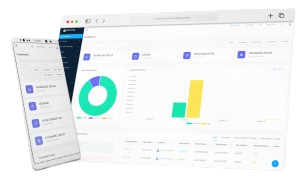Inventory forecasting is the process of predicting future inventory needs based on sales data, trends, and other factors. It is a big tool for businesses to ensure they have the right stock levels at the right time, avoiding costly stockouts and reducing excess inventory. By leveraging accurate forecasting, companies can streamline operations, meet customer demand, and improve overall profitability.
This method isn’t just about crunching numbers—it’s about making informed decisions that align inventory with actual demand. Whether you run a small retail store or manage a large supply chain, inventory forecasting helps you stay ahead by ensuring you’re prepared for fluctuations in sales and market trends.
Relying on guesswork or outdated methods can lead to lost sales, wasted resources, and frustrated customers. Inventory forecasting equips businesses with the insights they need to optimize stock levels, reduce costs, and boost revenue.
Benefits of Inventory Forecasting
Minimizes Stockouts
Stockouts result in lost sales and unhappy customers. Inventory forecasting helps you predict demand, ensuring you always have enough stock on hand. By knowing when and how much to reorder, you can keep your shelves stocked and your customers satisfied.
Reduces Inventory Holding Costs
Excess inventory ties up money and space. With forecasting, you buy only what you need, reducing storage costs and freeing up capital for other priorities. This keeps your inventory lean and your operations efficient and and optimized inventory holding fees.
Prevents Product Waste
Overstocking can lead to unsold items that expire or become obsolete. Forecasting highlights slow-moving products, allowing you to adjust your purchasing, repurpose stock, or bundle items to boost sales. This reduces waste and improves profitability.
By using inventory forecasting, businesses can operate more efficiently, cut unnecessary costs, and focus on meeting customer demands without overspending.
Inventory Forecasting Techniques
Trend Forecasting
This method uses past sales data to identify patterns and predict future demand. By analyzing upward or downward trends for specific products, businesses can adjust their inventory strategy to match customer preferences. Trend forecasting is ideal for understanding seasonal demand and planning ahead.
Graphical Forecasting
Converting sales data into graphs makes it easier to spot patterns and predict future needs. Visual tools help identify peaks and dips in sales, providing quick insights into how inventory should be managed. This technique is especially useful for businesses that rely on clear, actionable data to make decisions.
Qualitative Forecasting
When historical sales data is unavailable or unreliable, qualitative forecasting comes into play. It uses expert opinions, market research, and sales team feedback to estimate demand. This approach is perfect for new products or businesses entering a market with limited data.
Quantitative Forecasting
This method relies on historical sales data to predict future inventory needs. It’s highly accurate for established businesses with consistent sales records. By analyzing past performance, quantitative forecasting helps create data-driven strategies for stocking products efficiently.
Each technique offers unique benefits, and choosing the right one depends on your business needs and the data available. Effectively using these methods can help you balance supply and demand while reducing costs and improving customer satisfaction.
Core Formulas in Inventory Forecasting
Lead Time Demand
Lead time demand estimates the quantity of a product you’ll sell during the time it takes for your supplier to fulfill an order. This ensures you have enough stock to avoid running out while waiting for restock.
Formula:
Lead time demand = average lead time (days) × average daily sales
For example, if your average lead time is 10 days and you sell 20 units daily, your lead time demand is 200 units.
Reorder Point (ROP)
The reorder point tells you when to restock so you never run out of inventory. It considers both lead time demand and safety stock to ensure you’re covered for fluctuations in demand.
Formula:
ROP = (average daily sales × lead time) + safety stock
If your average daily sales are 20 units, lead time is 10 days, and safety stock is 50 units, the ROP is 250 units.
Safety Stock
Safety stock is the extra inventory you keep to handle unexpected demand or delays in restocking. Keeping the right amount of safety stock minimizes risks without increasing holding costs.
Formula:
Safety stock = (maximum daily sales × maximum lead time) – (average daily sales × average lead time)
For example, if your maximum daily sales are 30 units, maximum lead time is 12 days, average daily sales are 20 units, and average lead time is 10 days, your safety stock is 140 units.
Using these formulas ensures optimal inventory levels, avoids stockouts, and minimizes costs, keeping operations smooth and efficient.
How to Implement Inventory Forecasting in Your Business
Gather Accurate Data
Start by collecting key information such as sales history, lead times, and market trends. The more accurate your data, the better your forecasts will be. For new products, use industry benchmarks or qualitative insights to estimate demand.
Choose a Forecasting Model
Select the forecasting method that suits your business. Established businesses with consistent data may prefer quantitative forecasting, while new businesses can rely on qualitative methods. For detailed insights, consider combining multiple techniques, such as trend and graphical forecasting.
Set Key Metrics
Define essential metrics like lead time demand, reorder points, and safety stock. Use the formulas to calculate these values and adjust them regularly based on changes in sales patterns or supplier performance.
Use Technology
Leverage inventory management software to automate forecasting. These tools can analyze large datasets, generate accurate predictions, and update calculations in real-time, saving time and reducing errors.
Review and Adjust
Inventory forecasting is not a one-time task. Regularly review your forecasts, compare them with actual sales, and adjust as needed to reflect changing market conditions or customer preferences.
By following these steps, businesses can implement effective inventory forecasting, reduce costs, and ensure smooth operations while meeting customer demand.
Conclusion
Inventory forecasting is a vital tool for managing stock effectively and optimizing business performance. By accurately predicting future demand, businesses can prevent stockouts, reduce holding costs, and minimize waste. Whether you’re using trend analysis, graphical insights, or advanced forecasting formulas, the goal remains the same: to maintain the right balance between supply and demand.
Implementing inventory forecasting doesn’t have to be complex. With the right data, methods, and tools, you can streamline your inventory processes, save costs, and improve customer satisfaction. Start by gathering accurate data, choosing the best forecasting model, and regularly reviewing your strategy to stay ahead of market changes.
Mastering inventory forecasting ensures your business operates efficiently, stays competitive, and consistently meets customer needs.






